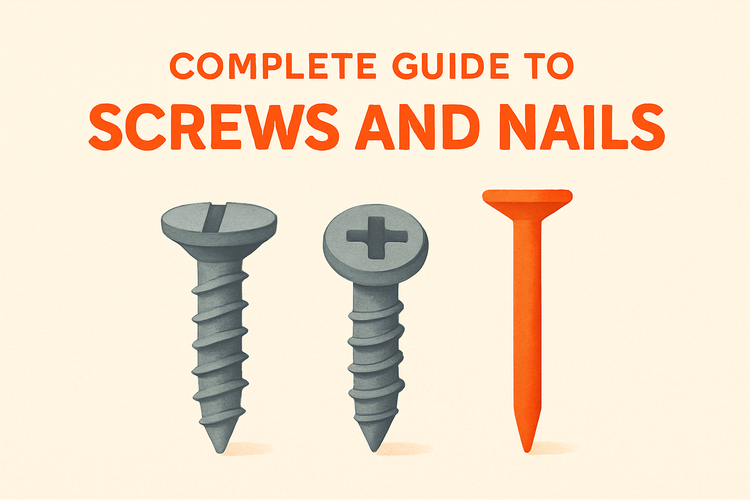Complete Guide To Screws And Nails

Understanding the Difference Between Screws and Nails
Choosing between screws and nails can significantly influence the durability and strength of your construction project. Understanding the fundamental differences helps ensure structural integrity and long-term performance.
Nails are typically used when shear strength is needed, as they can bend without breaking. They are ideal for applications like framing or installing hardwood floors where materials expand and contract. On the other hand, screws offer superior holding power due to their threaded structure, making them suitable for delicate or load-bearing applications like cabinetry or installing joist hangers.
Screws provide greater control during installation and removal, making them a preferred choice for projects that may be adjusted or repaired in the future. Nails, however, are generally faster to install—particularly with nail guns—which is why they remain common in large-scale construction work where speed is essential.
Both fasteners have specific use cases and your project's materials, load requirements, and environmental conditions should guide your selection. Pairing them with the proper hardware such as joist hangers or post bases further enhances their effectiveness and safety.
Types of Screws for Various Applications
Screws come in a variety of designs, each suited to specific applications in joinery, framing, and infrastructure.
Wood screws are among the most common types, with coarse threads designed to grip wood securely. These are ideal for general carpentry, attaching hinges, or securing boards. Drywall screws, on the other hand, are thinner and specifically built to bond drywall surfaces with wooden or metal frames without damaging the fragile drywall sheet.
Masonry screws are made of hardened steel and sometimes come with a protective coating to aid corrosion resistance. These are crucial when anchoring into brick, stone, or concrete and necessitate pre-drilling. Similarly, self-drilling screws, often used in metalwork, eliminate the need for pilot holes and speed up assembly time. They are frequently used alongside timber frame connectors to save labor effort during installations.
Decking screws and structural screws have added strength and weather-resistant features, making them perfect for outdoor use. Some include corrosion-resistant coatings or are made of stainless steel to withstand moisture and sunlight, reducing the likelihood of rust and failure over time.
Nail Types and Their Common Uses
Nails also come in varying shapes and sizes to meet the needs of different construction challenges.
Common nails, with their thick shanks, are best for framing work and provide strong holding power when driven into wood. Finishing nails, on the other hand, have smaller heads that can be concealed easily, making them suitable for trim and molding work. These nails ensure that aesthetics are maintained while still offering reliable hold.
Brad nails are even thinner and are typically used for delicate woodworking tasks like attaching lightweight trim or crafting cabinetry. For outdoor construction or moisture-prone environments, galvanized nails are recommended due to their protected coating that resists rusting. In structural applications involving components like angle brackets, it's crucial to use nails rated for the load-bearing capacity expected in the joint.
Ring shank nails offer extra grip by featuring ridges along the shank. This makes them highly resistant to pull-out, and they are often employed in flooring or roofing projects where structural integrity over time is critical. The choice of nail can greatly affect the performance and longevity of your construction work.
When to Use Screws Instead of Nails
Knowing when to opt for screws instead of nails can improve both safety and performance.
Screws are the better choice when precision is critical or when disassembly might be required later. They provide tighter clamping forces, which is essential in structural decking, cabinetry, or when anchoring posts using post bases. This strong mechanical hold ensures that joints do not shift due to load or vibration.
For engineered timber like Glulam or cross-laminated timber, screws are preferred because they reduce the risk of splitting and offer consistent holding power. These materials expand and contract less, and screws accommodate this better than nails which could loosen under dynamic conditions. Specialized screws made for glulam timber connectors ensure optimal surface contact.
Additionally, screws are less likely to deform under load and allow for cleaner finish work. In areas that require a more permanent fixture with little risk of backing out, screws offer a professional and secure solution. They also create less vibration during installation, reducing damage to delicate substrates.
Coatings and Materials: Maximizing Durability
The material and coating of a screw or nail play a pivotal role in the longevity of any structure, especially in outdoor or high-moisture environments.
Stainless steel is widely regarded for its rust-resistant properties, making it an excellent choice for coastal or damp conditions. Galvanized fasteners also resist oxidation and wear, extending structural life and reducing maintenance. When used with elements like restraint straps or roof connectors, selecting the right coating becomes even more vital to prevent corrosion at the junction point.
Phosphate-coated screws provide additional friction and corrosion resistance, especially useful in drywall installation where steel studs may be used. Ceramic-coated screws and nails, while more expensive, offer enhanced durability and are often used in high-stress applications such as fencing or decking exposed to weather extremes.
The environmental impact should also be considered. Zinc-coated fasteners are a more eco-friendly option and provide good corrosion resistance at a moderate cost. When efficiency, safety, and longevity are priorities, investing in correctly coated fasteners pays off over time and protects the surrounding structure.
